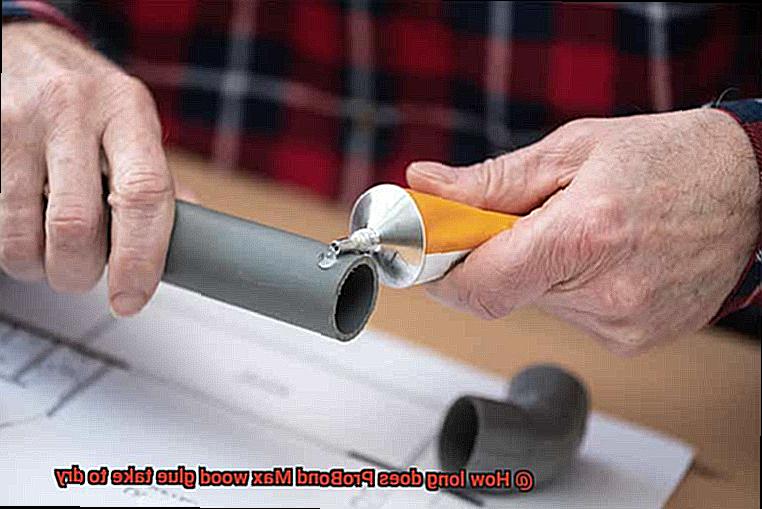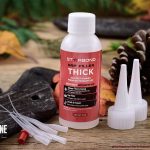When it comes to woodworking, a strong adhesive is the secret ingredient for success. That’s where ProBond Max wood glue comes in. This glue has become a favorite among DIY enthusiasts and professionals alike, thanks to its powerful bonding properties.
But there’s one question that keeps popping up: “How long does ProBond Max wood glue take to dry?”
How long does ProBond Max wood glue take to dry?
Contents
- 1 How long does ProBond Max wood glue take to dry?
- 2 How Long Does ProBond Max Wood Glue Take to Dry?
- 3 Factors Affecting the Drying Time of ProBond Max Wood Glue
- 4 Optimal Temperature and Humidity for Drying ProBond Max Wood Glue
- 5 Applying the Right Amount of Glue for Proper Bonding
- 6 Surfaces Affecting the Drying Time of ProBond Max Wood Glue
- 7 Clamping During the Drying Process
- 8 Durability and Waterproof Properties of ProBond Max Wood Glue
- 9 Conclusion
Drying Time of ProBond Max:
ProBond Max wood glue is known for its lightning-fast drying time, allowing you to finish your projects in record time. In most cases, you can expect the glue to be touch-dry within 20-30 minutes. However, keep in mind that drying times may vary depending on factors such as temperature, humidity, and the type of wood you’re working with.
Factors Affecting Drying Time:
- Temperature: Crank up the heat, and you’ll speed up the drying process. Cooler temperatures might slow things down a bit. For optimal drying time, aim for a temperature range of 55°F to 75°F (13°C to 24°C).
- Humidity: High humidity can put a damper on your project by prolonging the drying time. Make sure you’re working in a well-ventilated space with humidity levels around 45-55% for faster drying.
- Wood Type: Different woods have different levels of absorbency, which affects how quickly they soak up the glue and dry. Generally speaking, softer woods require less drying time compared to dense hardwoods.
Tips for Efficient Drying Time:
- Proper Clamping: To ensure speedy drying and a rock-solid bond, apply firm pressure when clamping your glued surfaces together. Get them nice and tight.
- Thin Layers: Don’t go overboard with the glue. Applying a thin layer allows for quicker evaporation and faster drying. Make sure to cover the surfaces evenly and avoid excess glue that might slow things down.
- Drying Environment: Set the stage for success by maintaining the perfect drying environment. Keep the temperature and humidity levels in check, and if needed, bring in fans or dehumidifiers to help you out.
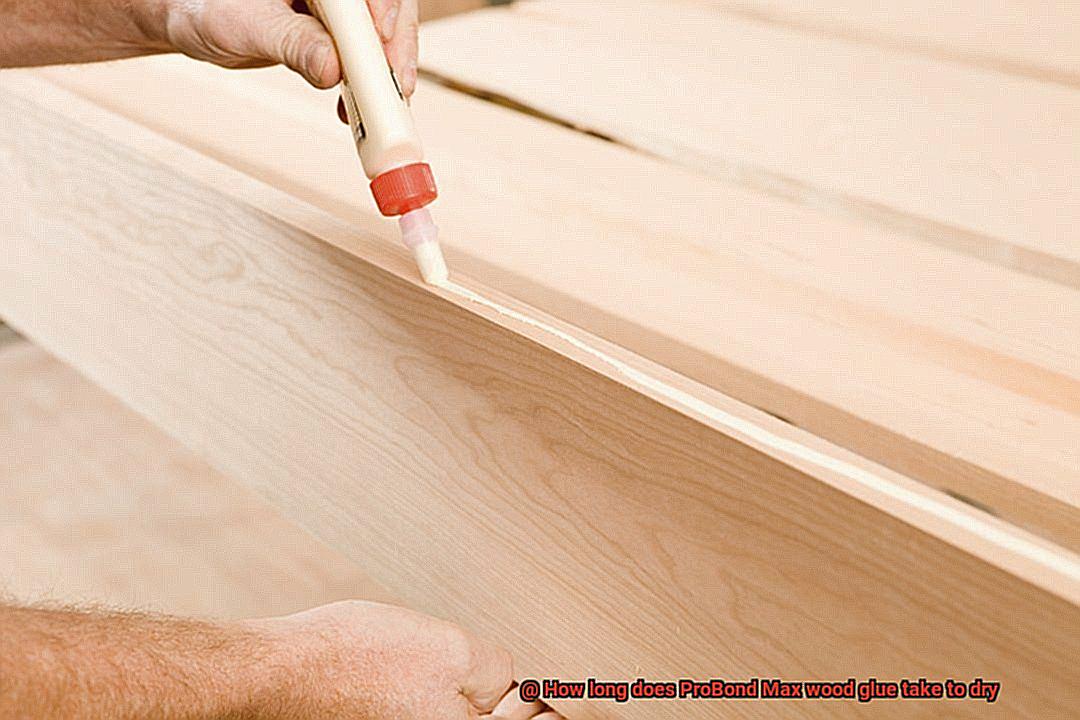
When it comes to reliable wood glue with lightning-fast drying times, ProBond Max is the real deal. With a typical drying time of just 20-30 minutes, this adhesive is perfect for both small DIY projects and large-scale woodworking endeavors. Just remember
How Long Does ProBond Max Wood Glue Take to Dry?
ProBond Max wood glue is a popular choice due to its exceptional bonding strength and versatility. But how long does it actually take to dry? In this comprehensive guide, we will explore the intricacies of ProBond Max wood glue drying time, uncovering the factors that influence it, and providing expert tips for achieving optimal results.
Factors Affecting Drying Time:
- Temperature: The ideal temperature range for ProBond Max wood glue drying is between 70°F and 85°F (21°C and 29°C). Higher temperatures expedite drying, while lower temperatures extend the process, requiring patience.
- Humidity: The drying time can vary based on humidity levels. Higher humidity prolongs drying, while lower humidity speeds it up. Working in a well-ventilated area with moderate humidity is recommended to maintain control over the process.
- Surface Type: Porous surfaces, such as raw wood, absorb more moisture from the glue, leading to longer drying times. Non-porous surfaces, like laminates, may require additional drying time due to limited airflow. Understanding your specific surface type is vital for accurate planning.
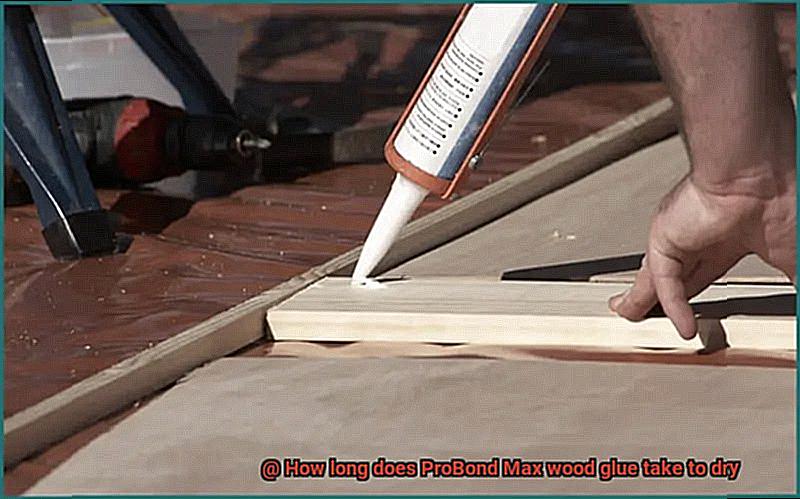
Proper Application Techniques:

- Apply Adequate Glue: Achieving a strong bond and reducing drying time depend on applying the right amount of glue. Too little results in weak bonds, while excessive amounts increase drying time. Follow the manufacturer’s guidelines on application and coverage for optimal results.
- Clamping: To ensure a durable bond, clamp the glued surfaces together during the drying and curing process. This prevents any movement that could compromise the bond’s strength. Follow the manufacturer’s instructions regarding clamping time to achieve maximum effectiveness.
Tips for Faster Drying:
- Optimal Conditions: Maintaining a workspace temperature of 70°F (21°C) and a humidity level between 40-60% accelerates drying. Creating an environment conducive to drying allows for efficient completion of your project.
- Heat Application: Increasing the temperature in the workspace or using a heat gun (with caution) can expedite drying. Ensure that heat is evenly applied and not excessive, as excessive heat can lead to bubbling or compromised bond strength.
Factors Affecting the Drying Time of ProBond Max Wood Glue
Well, we’ve got the inside scoop on what factors can affect the drying time of ProBond Max Wood Glue. So whether you’re a seasoned woodworker or just a DIY enthusiast, read on to discover how you can speed up the drying process and get back to your projects in no time.
First and foremost, let’s talk about temperature. The temperature of your environment plays a crucial role in how quickly ProBond Max Wood Glue dries. In simple terms, higher temperatures mean faster drying, while lower temperatures mean slower drying. So if you find yourself working in a chilly workshop, consider turning up the heat to get that glue to set faster.
But temperature isn’t the only thing to consider. Humidity levels also have a significant impact on drying time. In high humidity conditions, where there’s excess moisture in the air, the glue may take longer to dry. On the other hand, in low humidity conditions where the air is dry, the glue will dry faster. So if you live in a humid climate, investing in a dehumidifier for your workspace might be a wise move.
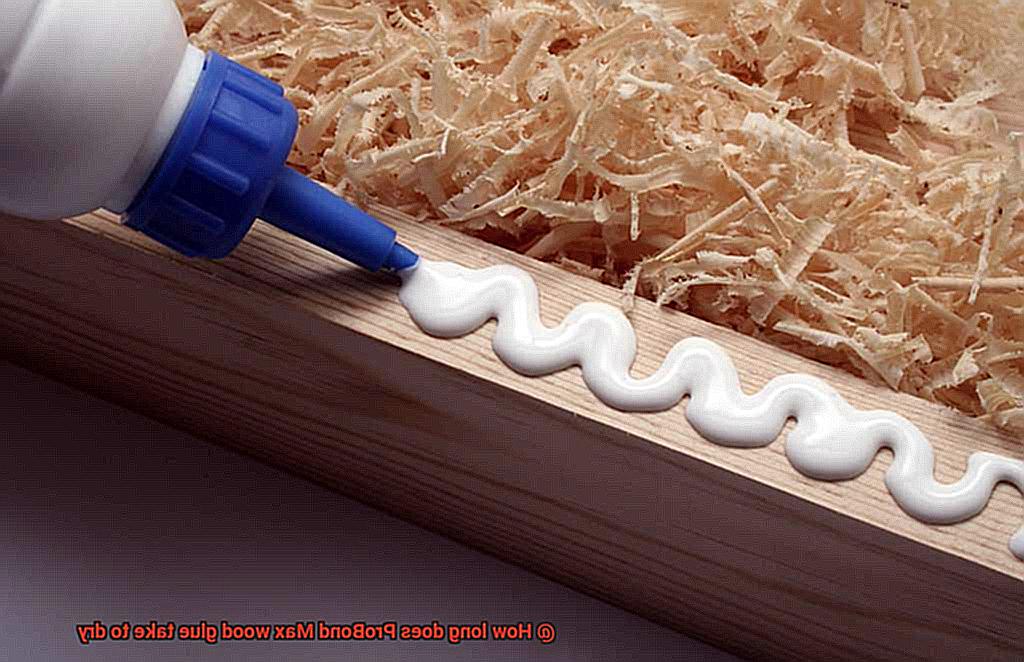
Now let’s talk about the type and thickness of wood you’re working with. Different woods have different levels of porosity, which means they absorb moisture from the glue at varying rates. Porous woods like pine or oak will take longer to dry because they absorb more moisture from the glue. On the flip side, denser woods like maple or teak will dry faster since they absorb less moisture.
Moving on to how you apply the glue. The way you apply ProBond Max Wood Glue can affect how long it takes to dry. Applying a thin and even layer of glue will result in quicker drying because there’s less moisture to evaporate. But if you apply too much glue or use an uneven application, it will take longer to dry because there’s more moisture to evaporate. So make sure to follow the manufacturer’s instructions for proper application techniques.
Let’s not forget about clamping pressure. When using ProBond Max Wood Glue, applying adequate clamping pressure is crucial for achieving a strong bond and reducing drying time. Clamping the glued surfaces together ensures maximum contact between the glue and the wood, allowing for better adhesion. Insufficient clamping pressure can result in weaker bonds and longer drying times as the glue may not be able to penetrate into the wood fibers effectively.
Lastly, let’s talk about air circulation. Proper airflow around the glued surfaces can help expedite the drying time of ProBond Max Wood Glue. Ventilation helps carry away moisture from the glue, allowing it to dry faster. So make sure there’s adequate airflow in your workspace to promote faster drying and prevent any potential issues caused by trapped moisture.
Optimal Temperature and Humidity for Drying ProBond Max Wood Glue
When it comes to woodworking projects, waiting for wood glue to dry can be a real test of patience. We all want that perfect bond to form quickly so we can move on to the next step. Well, get ready to discover the secret to optimal drying for ProBond Max wood glue – the perfect temperature and humidity.
Let’s start with the basics. ProBond Max wood glue is an adhesive specially formulated for bonding wood surfaces. It’s renowned for its strength and ability to handle heavy-duty applications. But when it comes to drying time, temperature and humidity are the power players.
So, what’s the magic temperature range? To achieve the best results, keep your workspace between 70°F (21°C) and 80°F (27°C). This sweet spot allows the glue to cure efficiently without compromising its strength. Be cautious though – extremely high temperatures may speed up drying but can lead to weaker bonds. Finding the right balance is key.
Now, onto humidity. Aim for a moderate level between 40% and 60% for optimal drying of ProBond Max wood glue. Higher humidity can slow down drying time, while lower humidity can cause the glue to dry too quickly, potentially weakening the bond. Avoid drastic fluctuations in humidity, as they can jeopardize the integrity of the adhesive bond.
To ensure consistent results, it’s best to control the environment where you’re drying ProBond Max wood glue. Consider using a temperature and humidity-controlled workspace or implement additional measures like dehumidifiers or humidifiers depending on ambient conditions. This will help maintain a stable temperature and humidity throughout the drying process, resulting in optimal bond strength and reducing the risk of failure.
Remember to take into account specific project requirements such as wood species, thickness, and surface preparation as they can influence drying times. Always refer to the manufacturer’s instructions for guidance on drying times and conditions.
Applying the Right Amount of Glue for Proper Bonding
When it comes to woodworking projects, achieving a strong and lasting bond is crucial for ensuring the longevity and durability of your creations. One key factor in achieving a proper bond is applying the right amount of glue. In this article, we will delve into the importance of using the correct amount of glue, along with the necessary tools and techniques needed to ensure a strong and reliable bond.
Types of Glue:
Before we dive into the importance of applying the right amount of glue, let’s briefly discuss the types of glue available for woodworking projects. ProBond Max wood glue is a popular choice due to its fast-drying formula and excellent bonding properties.
Specifically designed for woodworking applications, ProBond Max wood glue provides a strong and reliable bond on various wood surfaces.
Tools Needed:
To apply the right amount of glue, you will need a few essential tools. Firstly, make sure to have a clean cloth or brush on hand to remove any dust or debris from the surfaces you are bonding. This step is crucial as it ensures a clean and smooth surface for the glue to adhere to.
Additionally, having a brush, roller, or adhesive spreader will help you evenly distribute the glue over the surfaces, ensuring optimal coverage.
Techniques for Proper Bonding:
Now that you have your tools ready, let’s explore the techniques for applying the right amount of glue. Start by thoroughly cleaning and preparing the surfaces that will be bonded together. This step is vital as it ensures optimal adhesion between the materials.
Once cleaned, apply a thin and even layer of ProBond Max wood glue onto one of the surfaces using your preferred tool. It is important to avoid using excessive amounts of glue as this can result in messy squeeze-out and weaken the overall bond.
After applying the glue, firmly press the two surfaces together, ensuring uniform contact between them. Apply consistent pressure for a few minutes to allow the glue to bond properly. Keep in mind that drying times may vary depending on factors such as temperature, humidity, and wood type. While ProBond Max wood glue dries within 30 minutes to 1 hour, it fully cures after 24 hours.

Surfaces Affecting the Drying Time of ProBond Max Wood Glue
Wood glue is a vital tool in woodworking projects, and understanding the factors that influence its drying time is essential for achieving optimal results. In this article, we will explore how different surfaces, textures, temperatures, humidity levels, and intended uses can impact the drying time of ProBond Max wood glue.
Surface Type:
The type of surface onto which the glue is applied plays a significant role in its drying time. Porous surfaces, such as unfinished wood or unsealed MDF, absorb the glue more readily, resulting in a longer drying time. Non-porous surfaces like laminates or sealed wood tend to have a faster drying time as the glue does not penetrate deeply into the material.
Surface Texture:
Surface texture also affects drying time. Rough or uneven surfaces may require more glue to fill in gaps, which extends the drying time. Smoother surfaces allow for better adhesive coverage and quicker drying.
Temperature:
Temperature plays a crucial role in the drying process. Higher temperatures expedite the evaporation of moisture in the glue, accelerating drying time. Conversely, cooler temperatures slow down evaporation and prolong drying time.
Humidity Levels:
Humidity levels in the environment can impact drying time as well. Low humidity facilitates faster drying as moisture evaporates quickly. High humidity slows down evaporation and extends drying time.
Intended Use:
Considering the intended use of the object being glued is important. ProBond Max wood glue is designed for interior use only. If used on exterior surfaces exposed to moisture and extreme weather conditions, it may significantly affect drying time.
Clamping During the Drying Process
Today, we embark on an exciting journey into the world of glue, where we will discover the transformative role of clamping during the drying process of ProBond Max wood glue. Prepare to be amazed, for clamping is not just a mundane task but the unsung hero that guarantees the longevity of your wooden creations.
The Role of Clamping:
Imagine clamping as a magical act that applies pressure to your glued surfaces, using clamps or other ingenious tools. This seemingly simple step is a game-changer, as it prevents any unwanted movement or separation of the glued pieces, resulting in bonds as formidable as Hercules himself.
The Perfect Timing:
The burning question: how long should those clamps stay on? Fear not, my friend, for this depends on several factors. Firstly, the type of wood you’re working with determines its unique drying time, so conduct thorough research. Secondly, take into account the temperature and humidity levels in your environment as they significantly impact drying time. Lastly, always consult the manufacturer’s instructions for precise guidance.
Initial Clamping vs. Curing Time:
During the initial clamping period, lasting between 30 minutes to an hour, the glue sets and weaves its magic by bonding wood fibers together. But let us not forget that this is just the beginning of our grand adventure. After this initial phase, it is vital to leave your glued pieces undisturbed for a more extended duration, allowing the glue to fully cure and reach its maximum strength. The curing time can range from several hours to a full day or longer, depending on various factors.
Finding Balance:
In our woodworker’s dance, balance reigns supreme. Excessive clamping pressure can lead to glue squishing out or even distorting your precious wooden masterpieces. To avoid this sticky situation, consider the art of using cauls or blocks of wood in conjunction with clamps. This clever technique helps distribute pressure evenly across the surfaces, preventing any potential damage. It’s a delicate dance, but mastering that perfect balance will yield exceptional results.
The Final Touch: Cleanliness:
Before the glue sets completely, it is crucial to tidy up any excess adhesive. ProBond Max wood glue can be swiftly wiped away with a damp cloth while still wet. However, if any dried glue residue remains, fear not. Armed with a sharp chisel or scraper, you can effortlessly remove it, ensuring a pristine and professional finish.
Durability and Waterproof Properties of ProBond Max Wood Glue
In the world of woodworking, the choice of glue can be the difference between a masterpiece that stands the test of time and one that crumbles with the slightest touch. Enter ProBond Max wood glue, a true superhero in the realm of adhesives, celebrated for its exceptional durability and formidable waterproof properties. In this blog post, we will delve deeper into the secrets that make ProBond Max an unparalleled choice for your woodworking projects, elevating them to new heights.
The Mighty Formula:
At the heart of ProBond Max’s power lies its advanced formula, incorporating special resins crafted to forge unyielding bonds between wooden surfaces. These resins penetrate deep into the wood fibers, establishing a secure connection capable of withstanding heavy loads and relentless stress. Say farewell to weak joints and prepare to embrace a lifetime of unrivaled durability.
Defying the Elements:
ProBond Max wood glue is not one to shy away from a challenge. Its fully cured bond not only resists moisture but also triumphs over water and temperature fluctuations. Whether your project is destined for indoor or outdoor use, rest assured that your handiwork will remain rock-solid, even in the face of rain, humidity, and extreme temperatures.
From outdoor furniture to decks and wooden structures near water sources, ProBond Max stands tall against nature’s forces.
Flexibility for Longevity:
The secret to ProBond Max’s enduring strength lies in its remarkable ability to flex and move with the wood. This unique characteristic allows the glue to absorb vibrations and movements without compromising the bond.
As a result, your glued joints are less likely to crack or fail over time, ensuring a long-lasting and reliable connection that defies wear and tear.
Time is of the Essence:
ProBond Max wood glue sets quickly, within 30 minutes to 1 hour, providing an initial bond with impressive strength. However, patience is key, as it takes up to 24 hours for the glue to fully cure and reach its maximum potency.
Keep in mind that drying times can vary based on factors such as temperature, humidity, and the thickness of the glue line. Give your project the time it deserves, and you will be rewarded with an unbreakable bond that stands strong.
Secrets to a Waterproof Bond:
To unlock the full waterproof potential of ProBond Max wood glue, apply a thin layer on both surfaces before joining them. This ensures complete coverage and creates a bond that can resist water and moisture with unparalleled efficacy. With this straightforward step, you can embark on your woodworking projects with confidence, knowing that they will remain intact even in the face of wet conditions.
U0hhFjjW5EU” >
Conclusion
ProBond Max wood glue is known for its quick drying time, allowing you to complete your woodworking projects efficiently. The exact drying time can vary depending on various factors such as temperature, humidity, and the type of wood being glued. However, in optimal conditions, ProBond Max wood glue typically dries within 30 minutes to an hour.
With its fast-drying formula, ProBond Max wood glue ensures that you don’t have to wait around for hours or even days for your project to be ready. This means you can move on to the next steps sooner and enjoy the satisfaction of seeing your creation come together swiftly.
The short drying time of ProBond Max wood glue is especially beneficial when working on time-sensitive projects or when you simply want to minimize downtime. Whether you’re building furniture, repairing a wooden structure, or engaging in any other woodworking endeavor, this reliable adhesive will help you save valuable time without compromising on quality.
Furthermore, ProBond Max wood glue offers a strong bond that withstands the test of time. Once it’s fully dried, you can trust that your glued joints will stay secure and durable. This peace of mind allows you to confidently tackle any woodworking project knowing that your hard work will pay off in the long run.
In conclusion, if you’re looking for a wood glue with a quick drying time and dependable strength, ProBond Max is an excellent choice. Its efficient drying time of approximately 30 minutes to an hour ensures that you can proceed with your project promptly while maintaining high-quality results.

